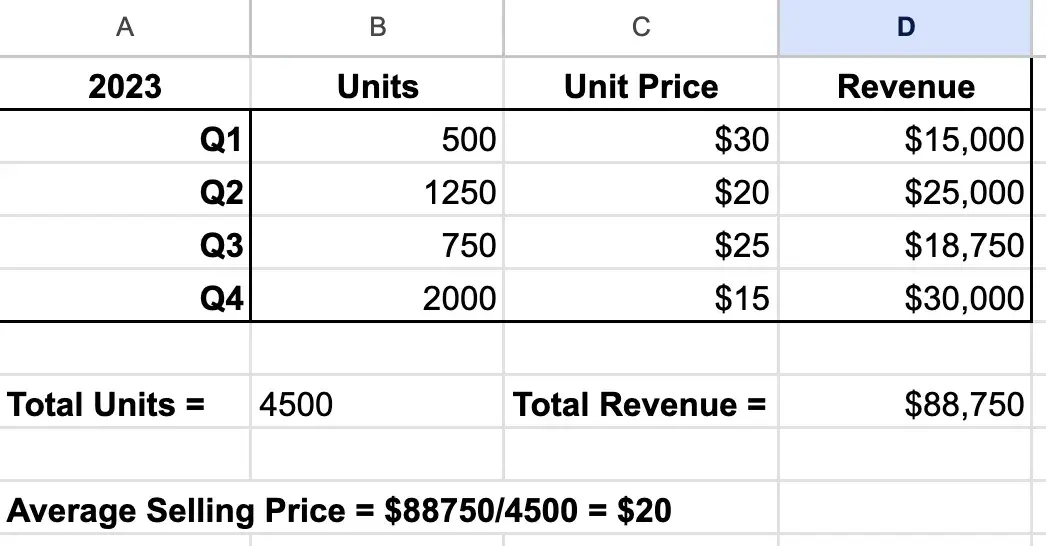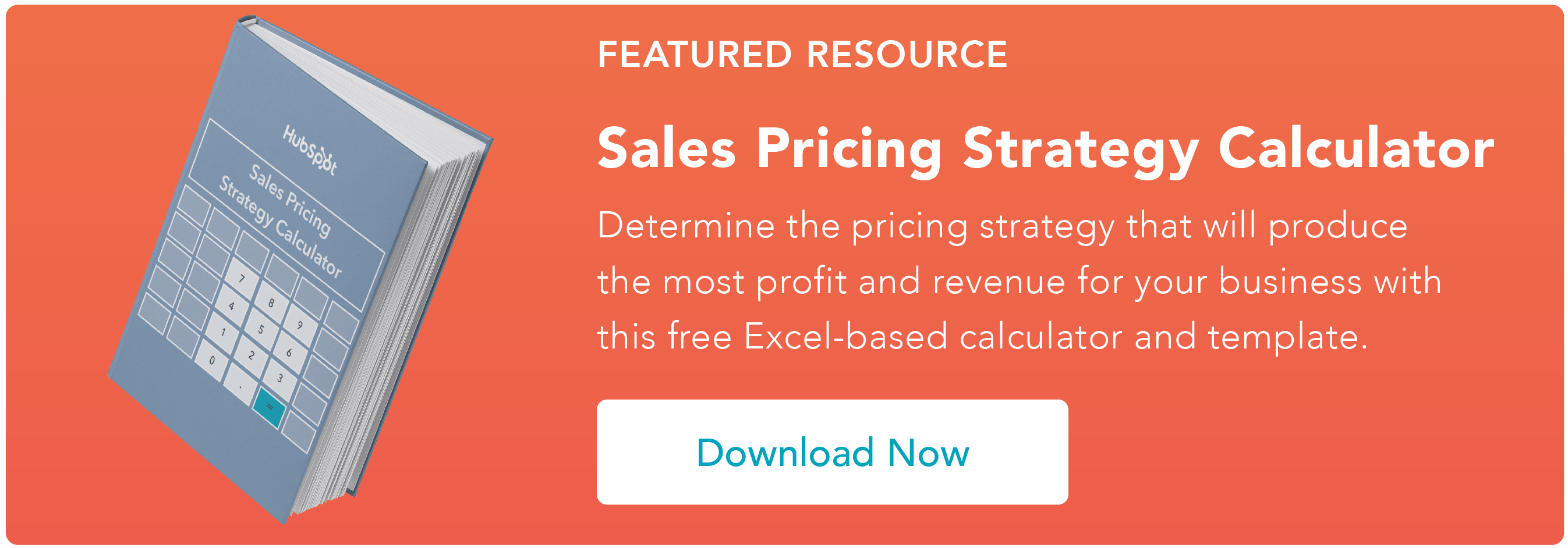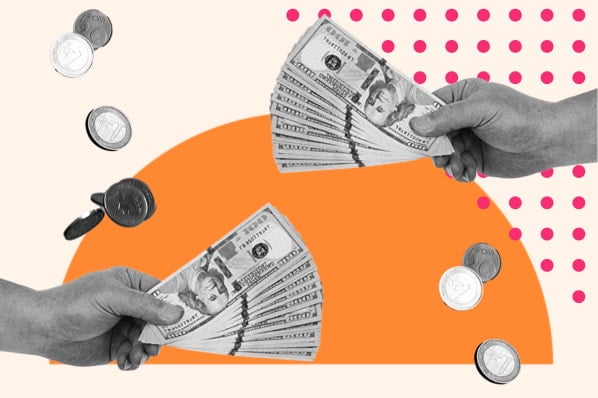Why would a company purposefully sell items at the same (or different prices) only to average the selling prices later for reporting purposes? Well, the average selling price can reveal a lot about the health of a company.

Read further to get a better understanding of the average selling price and how to calculate it for your business.
Table of Contents
- What is a selling price?
- What is an average selling price?
- How can I use an average selling price?
- How to Calculate Average Selling Price
- Is the average selling price right for your business?
What is a selling price?
The selling price is how much a buyer pays for a product or service. The selling price can also be known as market, list, or standard price.
The following factors help organizations determine the selling price of their products:
- The price a buyer is willing to pay.
- The price a seller is willing to accept.
- The price that’s competitive in the market.
- The price of COGs (Cost of Goods).
Depending on the type of business you own and the offerings you sell, you might prioritize one of these factors over the others.
Business executives and investors pay close attention to the average selling price because it is a reliable indicator of a company’s financial performance. In most cases, the higher the average selling price of a product, the better. But in some cases, like start-ups or businesses making a comeback, a low average selling price can be a smart, short-term strategy to penetrate the market.
The average selling price can also summarize these factors and help you determine the price you should assign your product.
Remember, your average selling price and “the interplay between demand and supply serves as a barometer of economic health,” as ecommerce author Neeraj Singh says.
Your pricing model determines your customers, positioning, packaging, channels, and margins.
Ash Maurya, pricing expert and founder of LeanStack, warns, “If you don’t choose your pricing, the market pushes you towards the average. If you chase average pricing, you become average. Don’t leave your pricing for others to determine.”
Pro tip: Creating high demand for a product can greatly influence its selling price. Check out this blog on creating high demand.
.png)
Free Sales Pricing Strategy Calculator
Determine the best pricing strategy for your business with this free calculator and template.
- Cost-Plus Pricing
- Skimming Strategy
- Value-Based Pricing
- And More!
What is an average selling price?
Average selling price (ASP) is the amount of money a product in a specific category is sold for across different markets and channels. This metric is typically affected by the type of product and its life cycle.
For example, electronics have a higher average selling price than books. Alternatively, electronics typically have a shorter product life cycle than books. Take the first generation iPhone and the J.K. Rowling novel, “Harry Potter and the Deathly Hallows.” Both products came out in 2007.
The iPhone and the seventh Harry Potter novel have different life cycles. The 2007 iPhone’s product life cycle immediately shortened with the release of the 2008 iPhone 3G. While it could be considered a collector’s item, its function is effectively useless after years of new devices and software updates.
The novel, however, has an infinite life cycle. As long as people are reading, its product life cycle continues.
Pro tip: It’s important to remember that if you’re running promotions on your ecommerce website, you will want to let retail partners know so they can competitively price the product because you wouldn’t want to hurt your partners’ bottom line in the meantime.
How can I use an average selling price?
Create a market entry strategy.
If you’re entering a new market, you need to determine the price of your products or services. Using the average selling price facilitates this process.
Once you calculate this metric, your company can use this information to set itself apart as a luxury or value retailer. Based on the ASP, increasing your prices can give your company the appearance of premium products; however, this higher cost can lead to fewer sales. Alternatively, if you set your cost below the ASP, your company might sell more but deal with smaller profit margins.
Pro tip: You will want to keep track of your average selling price and margins over the calendar year. The boundary you have on how often you discount a product and how low it can be is known as your MAP (Minimum Advertised Price) policy.
Identify trends.
Using an average selling price will help your company identify trends in the market. Let’s use headphones to demonstrate this. Say a company like Bose released a set of headphones for $300 last year, and they made 150,000 sales. This year, they released their newest pair at $250 and sold 250,000 units. Although the company dropped the cost of their product, this decrease incentivized more customers to make a purchase and led to a $17.5 million increase.
If a new or existing company was preparing to launch a new product in this industry, identifying this trend could expedite settling on a market price.
Pro tip: Check out this free template to help you conduct market research and identify the best price.
Make conclusions about products and services.
Do you keep a product, or do you scrap it? The average selling price helps your company decide. If you increase your selling price due to ASP and notice a drop in sales, that is not necessarily surprising. Alternatively, if a decrease in your price still leads to a fall in sales, it is time to pay attention. While multiple factors could be at play, ASP will ultimately help you decide if you need to work on a strategy for the product or remove it from your catalog.
Supply and demand also play a key role in determining product quality. Assistant Manager of EU Finance Mohamed Hagag describes this as “supply and demand are fundamental principles in economics that describe the relationship between the quantity of a good or service supplied by producers and the quantity demanded by consumers.”
Pro tip: Marketing and sales should attend any meetings that discuss a product’s end-of-life cycle. Sometimes, a product just isn’t getting the push it needs to succeed rather than needing to be retired.
How to Calculate Average Selling Price
Average selling price (ASP) is the amount of money a product in a specific category is sold for across different markets and channels. To calculate the average selling price of a product, take the total revenue earned from the product or service and divide it by the number of products or services sold.

Pipedrive, HubSpot, and Salesforce are three of the top sales tracking software tools in the industry. Instead of calculating your average selling price in a spreadsheet, these tools make the process easier.
When using HubSpot’s CRM, first, make sure you look at deals that closed in your desired period. The data you need is the sum of the total revenue from the closed-won deals and the number of units from the closed-won deals. To find the average selling price, divide the sum of the total revenue by the total number of units.
Pro tip: Even if you are not using sales tracking software, the average selling price is still painless to calculate with spreadsheet software. To use this tool, add up all the columns with your sales revenue numbers and divide by the number of units sold.

Average Selling Price Formula
The average selling price formula is: Average Selling Price = Total Revenue Earned by a Product ÷ Number of Products Sold
Actual Selling Price Formula
Now that we understand the average selling price and how to calculate it, let’s apply this concept to the actual selling price and apply these formulas to a scenario.
For example, we have determined that the average selling price for Android smartphones is $261. Let’s say you’re trying to determine a price for your new state-of-the-art cell phone. You would likely price your product above the average to stand out as a high-tech phone provider.
But how much is enough — or worse — too much? Luckily, you won’t need to guess this number. A simple formula can calculate the actual selling price of your mobile phone.
The selling price formula is:

Cost of Goods (COG) is the price a retailer pays for the product, including the product itself and any packaging. The profit margin is a percentage of the cost price.
Let’s define the key elements in the formula.
- COG: The price a retailer paid for the product.
- Profit Margin: A percentage of the cost price.
The actual selling price can tell you how much to price your high-tech cell phones. Once your product life cycle is nearing completion, you can calculate the average selling price of your luxury phones to see how it compares to the price you sold them for and the average selling price of basic, low-tech phones.
Pro tip: There are different ways to improve your margins that don’t involve selling more products. For example, maybe you can use a different type of packaging that uses less plastic or is cheaper, improving your margins. Evaluating the COG frequently can help you increase revenue.
How to Calculate Selling Price Per Unit
Follow Along With HubSpot’s Sales Pricing Calculator
If your business purchases inventory in bulk and sells it, you’ll want your selling price per unit to be higher than what you paid to turn a profit. Otherwise, you’ll break even on revenue. While that’s not as bad as losing money, it’s certainly not as good as making it.
For example, Hot Pie’s Bakery Supply needs to calculate the selling price for its product line of bread machines. The business purchased 20 bread machines for $3,000.
- Total cost of units purchased: $3,000
- Number of units purchased: 20
- Cost price: $150 ($3,000/20)
Now, it’s time to plug the numbers into the selling price formula. The cost price for each bread machine is $150, and the business hopes to earn a 40% profit margin. Here is what the selling price formula would look like in action:
Selling Price = $150 + (40% x $150)
Selling Price = $150 + (0.4 x $150)
Selling Price = $150 + $60
Selling Price = $210
Based on the formula, Hot Pie's Bakery Supply has a selling price. Each bread machine will be sold to buyers for $210.
Let’s fast-forward one quarter. Hot Pie finished the quarter with $4,000 in revenue. The business leaders want to know the average selling price of Hot Pie’s bread machines.
Total revenue: $4,000
Number of products sold: 20
Here’s the formula for the average selling price in action:
Average Selling Price = $4,000 ÷ 20
Average Selling Price = $200
This is an example where the actual selling price and the average selling price don’t match exactly. It happens for several reasons, like introducing a lower-priced sale item to sell inventory faster or an unplanned discount to smooth over a customer interaction. It might also occur if you don’t account for selling price factors.
Pro tip: Selling a product for very little margin or profit is not unheard of and could still be a good strategy. Consider Costco, which sells rotisserie chickens for no or hardly any profit yet gets customers into its store with these sales. Sometimes, margins need to be sacrificed to get the results you want.
Is the average selling price right for your business?
Both actual and average selling prices are critical to telling the financial story of a business. If the pricing is not based on what a buyer is willing to pay or competition in the market, you may end up with a pricing strategy that doesn’t make you money.
With the correct selling price in place, your business can earn a profit and win over loyal customers along the way.
Editor's note: This post was originally published in April 2019 and has been updated for comprehensiveness.








![Price Skimming: All You Need To Know [+ Pricing Calculator]](https://blog.hubspot.com/hubfs/price-skimming-strategy.jpg)


![B2B Pricing Models & Strategies [+ Pros and Cons of Each]](https://blog.hubspot.com/hubfs/b2b-pricing-models-and-strategies.jpg)
